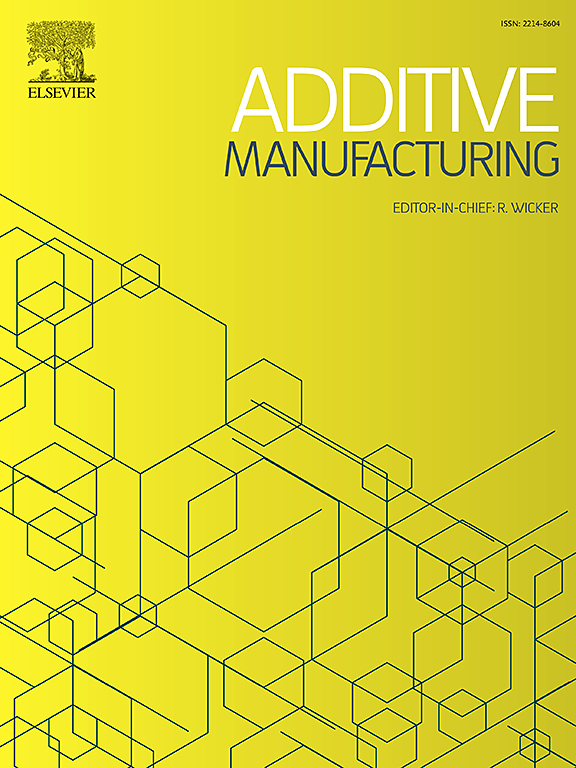动态交联聚二甲基硅氧烷外场诱导高速烧结:力学性能和电磁波吸收
IF 10.3
1区 工程技术
Q1 ENGINEERING, MANUFACTURING
引用次数: 0
摘要
外场诱导高速烧结(HSS)是一种粉末床熔融3D打印技术,采用红外光区域扫描代替激光点扫描和熔融,显著提高了打印速度。高速钢打印需要开发具有快速熔融凝固动力学的新材料来适应其快速烧结工艺。本文合成了具有动态咪唑键的聚二甲基硅氧烷(PDMS)共价自适应网络(can),并进一步粉碎制备了用于HSS 3D打印的弹性体粉末。通过优化打印工艺参数,可以实现高质量的尺寸精度和机械强度良好的PDMS弹性体零件的hss打印。真空浸渍和加热后处理工艺可以进一步改善表面外观和机械强度。打印的PDMS零件的抗拉强度为4.24 MPa,可以多次愈合,效率接近100% %。令人惊讶的是,HSS打印部件具有良好的超宽带电磁波(EMW)吸收功能,并且可以通过改变打印参数来调节。喷墨打印的炭黑颗粒在打印过程中形成亚微观层状结构,作为HSS打印的红外吸收剂,可以诱导emw的多次反射和折射,显著减弱其强度。样品厚度为28.3 mm时,有效吸收带宽(EAB)为14 GHz(4 ~ 18 GHz)。仿真结果表明,极化损耗、传导损耗和四分之一波长干扰是造成电磁波能量耗散的主要原因。本文章由计算机程序翻译,如有差异,请以英文原文为准。
External field induced high speed sintering of dynamically cross-linked polydimethylsiloxane: Mechanical properties and electromagnetic wave absorption
External field induced high speed sintering (HSS), is one kind of powder bed fusion 3D printing technology, which significantly enhances the printing rate using infrared light area-scanning instead of laser point-scanning and fusion. HSS printing needs to develop new materials with rapid melting-solidification kinetics to adapt to its rapid sintering process. Here, the polydimethylsiloxane (PDMS) covalent adaptable networks (CANs) with dynamic imidazolium bonds were synthesized and further pulverized to make the elastomer powders for HSS 3D printing. The high-quality PDMS elastomer parts with good dimension accuracy and mechanical strength can be HSS-printed through the optimization of printing processing parameters. A post-treatment process with vacuum impregnation and heating can further improve the surface appearance and mechanical strength. The printed PDMS parts exhibit a tensile strength of 4.24 MPa and can be healed multiple times with an efficiency of nearly 100 %. A surprising finding is that the HSS printed parts have a good ultra-broadband electromagnetic wave (EMW) absorption function, which also can be tuned by altering the printing parameters. The sub-microscopic layered structures of the inkjet-printed carbon black particles used as infrared absorbers of HSS printing were formed during the printing process, which can induce the multiple reflections and refractions of EMWs, significantly attenuating their intensity. At a specimen thickness of 28.3 mm, an effective absorption bandwidth (EAB) of 14 GHz (4–18 GHz) can be achieved. The simulation results indicate that polarization loss, conduction loss, and quarter-wavelength interference are responsible for the electromagnetic waves' energy dissipation.
求助全文
通过发布文献求助,成功后即可免费获取论文全文。
去求助
来源期刊

Additive manufacturing
Materials Science-General Materials Science
CiteScore
19.80
自引率
12.70%
发文量
648
审稿时长
35 days
期刊介绍:
Additive Manufacturing stands as a peer-reviewed journal dedicated to delivering high-quality research papers and reviews in the field of additive manufacturing, serving both academia and industry leaders. The journal's objective is to recognize the innovative essence of additive manufacturing and its diverse applications, providing a comprehensive overview of current developments and future prospects.
The transformative potential of additive manufacturing technologies in product design and manufacturing is poised to disrupt traditional approaches. In response to this paradigm shift, a distinctive and comprehensive publication outlet was essential. Additive Manufacturing fulfills this need, offering a platform for engineers, materials scientists, and practitioners across academia and various industries to document and share innovations in these evolving technologies.
 求助内容:
求助内容: 应助结果提醒方式:
应助结果提醒方式:


